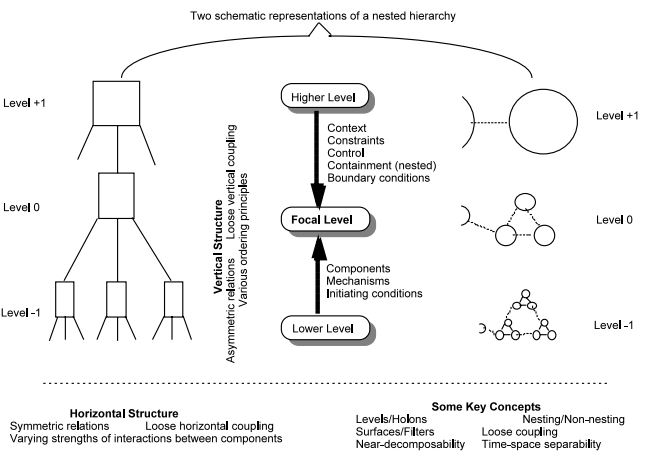A spatial explicit hierarchical approach to modeling complex ecological systems: theory and applications
http://dx.doi.org/10.1016/S0304-3800(01)00499-9
Authors present a spatially explicit hierarchical modeling framework for investigating complex ecological systems using a multiple-scale methodology.
This article can be broken up into two sub-papers. The first portion of the paper serves as a review of hierarchical modeling in ecology and other related disciplines, ending with a conceptual overview of the proposed framework. While the second portion of the paper is a demonstration of the proposed framework.
Background Summary
The authors spend some time providing an overview of hierarchical theory which serves to provide a historical context for hierarchical modeling in ecology. They first offer up insight into the notion that complexity in ecological systems can mostly exist due to the stability offered from hierarchical structure, and that hierarchical structures evolves in an increasingly complex system by it’s strong affect on stability. Furthermore, they reiterate the four components of a complex system from Levins 1999 which are the following: (1) heterogeneity, (2) non-linearity, (3) hierarchical organization, (4) flows. Which are components that have been acknowledged in our class discussion. Background information also provides a discussion on several terms that would be important in a hierarchical framework, including but not limited too: levels, holons, system decomposition, coupling, nested hierarchy, non-nested hierarchy.

Lastly, they discuss the three important components to the hierarchical patch dynamics scaling ladder approach.
HPD – Scaling ladder approach
- Identifying appropriate patch hierarchies
- Making Observations and developing models at focal levels.
- Extrapolating informaiton across the domains of scale hierarchically.
Applications of a hierarchical patch dynamics model
Understanding the consequences of increased urbanization for ecosystems at local and regional scales is an important topic for both natural resource managers and city planners. Presented in the second portion is a description of the HPDM for the city of Phoenix, Arizona.
The essential levels of the model from bottom to top are local ecosystem, local landscape, and regional landscapes. At the lowest level, researchers employ two broad ecosystems models (CENTURY and PALS) each providing different simulations for various nutrient cycles. The selection of two different ecosystem models was made to allow better identify which mechanisms could be potentially ignored or condensed into a phenomenological relationship.
Authors provide some detail on the coding required for model development under the section titled ‘developing a hierarchical patch dynamics modeling platform’.
Researchers provide two working examples using the presented framework. The first example demonstrates how a cellular-automata model can be utilized to predict uban development over a 30 year time period, using the preceding two decades as training data. This model only emphasizes recreating the spatial patterns observed at a broad landscape scale, and does not make much consideration for lower level mechanisms.
The second example presented emphasizes linking observed spatial pattern and processes. This approach incorporates the change in native plant species due to modification of regional flood regimes from increased urbanization. Researchers demonstrate that changes to the hydrology has increased the local ecosystem’s susceptibility to invasion from exotic species.
